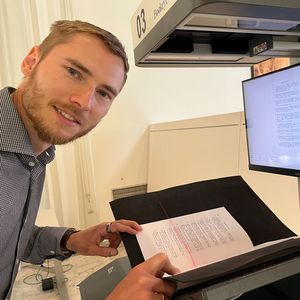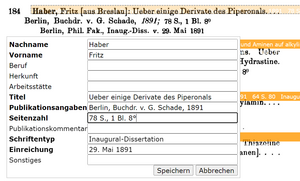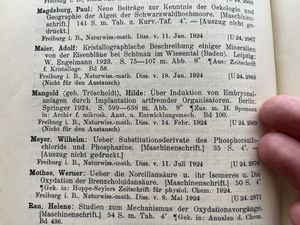Citizen Science thrives on the interaction between citizens and researchers. The interest in cooperation is steadily growing. Well-known projects in the environmental area include bird counting and bee observation.
Since December 2021, the MPI for Innovation and Competition has now been cooperating with the German Association for Computer Genealogy (CompGen) in a data project to record the annual directories of publications at German universities and higher education institutions. The directories, which were published between 1885 and 1987, first by the Royal Library in Berlin and later by the German Library in Leipzig, cover 103 volumes. They list mainly dissertations and postdoctoral theses written at German universities and higher education institutions. Afterwards, the directories were discontinued in this form. A digital continuation failed.
For citizens who conduct genealogical or family research, the lists, some of which contain rich biographical information, are interesting because they hope to meet ancestors, bearers of the same name or people from their town or region. Birgit Casper, who is working on the project, reports on her motivation for collecting the data: “I know two doctors in my family. Of one, born in 1891, I know pretty much where he studied and that he submitted his dissertation ‘On cases of poisoning with American worm seed oil’ to the medical faculty in Rostock in 1920. Of the other, born in 1892, I only know where he practiced medicine as of 1924. I do not know where he studied, nor when and on what subject he did his doctorate. Here I am waiting for the corresponding volume.”
For scientists, the lists are intriguing because they provide a complete overview of researchers who were educated at German universities since 1885 and some of whom were internationally important. Since German universities were internationally leading in almost all disciplines at the turn of the century, the project promises particularly interesting insights. We find the dissertations of numerous later Nobel Prize winners, such as Walther Nernst, who received the Nobel Prize in Chemistry in 1920 and was on the board of directors of the Kaiser Wilhelm Institute (KWI) for Physics, as well as Werner Heisenberg, who later gave his name to the subsequent MPI for Physics, and also Maria Goeppert-Mayer, who was awarded the Nobel Prize in Physics in 1963 as the first female German Nobel Prize winner.
The first regular doctorate for a woman will also be found in the lists. In fact, women were severely underrepresented at first. Only a few were allowed to earn a doctorate before 1900, and only with special permission. It was only between 1901 and 1908 that the German states successively admitted women to their universities. The right to pursue doctoral studies, however, was awarded by the faculties themselves. A systematic recording of all dissertations will thus generate a complete overview of when, at the latest, women were allowed to earn a doctorate at which universities and faculties. The right to habilitation – the path to professorship – was given to them even later: Here, too, the lists can help shed light on the situation.
How does the collaboration between science and amateurs work in the project?
To find volunteers who want to work on the project, CompGen publishes calls and updates on Twitter and in the blog on the Compgen website. On a special wiki page for the project, volunteers can register, learn about the editorial guidelines, and start editing data right away.
Michael E. Rose, Senior Research Fellow at the MPI for Innovation and Competition, who leads the project and is active in the field of Science of Science, is gradually scanning the directories.
Then the lists are captured with a text recognition program and roughly segmented: What are first name, last name, title of the dissertation, the date of the defense, other details? The volunteers use the infrastructure provided by the association (input mask and data repository) to proofread the entries and add to them manually. The entered records are immediately available for search queries. So far, seven annual directories have been processed. After completion of the project, the lists, which are interlinked, for example, to the German National Library, Wikipedia, and Scopus, a multidisciplinary abstract and citation database for research literature, will be publicly available as research data.
One of the best-known personalities recorded so far is Fritz Haber, who, as founding director, headed the KWI for Physical Chemistry and Electrochemistry in Berlin for 22 years, which is now named after him. His dissertation, „Ueber einige Derivate des Piperonals“ (On some derivatives of piperonal), a fungicidal fragrance, is found in volume VI (1890/91). Fritz Haber received the Nobel Prize in 1919, awarded for the year 1918, for his research on the catalytic synthesis of ammonia, i.e., in a different field of research from his dissertation.
Max von Laue, on the other hand, who completed his doctorate with Max Planck in 1903 „Über die Interferenzerscheinungen an planparallelen Platten“ (On the interference phenomena in plane-parallel plates), continued to pursue the research begun with his dissertation – until he was awarded the Nobel Prize in 1914 for his work on X-ray interferences.
However, not all doctoral graduates were able to receive the recognition they deserved. Hilde Mangold’s research in the field of embryology led to a Nobel Prize in 1935 for her doctoral advisor Hans Spemann, who was director at the KWI for Biology in Berlin-Dahlem during the First World War. Mangold herself died in a fire shortly after defending her dissertation in 1924. After all, the prize-winning discovery, the Spemann organizer, is sometimes called the Spemann-Mangold organizer.
Due to their depth of detail and completeness, the data digitized in the project allow for numerous exciting research questions. Can we read problems of an era from law dissertations? How do the demographics and social origins of doctoral students change over time and at individual universities? Who were the women who were the pioneers in earning a doctorate? What is the relationship between dissertations and patent activity?
However, before that, the dataset must be completed, and every hand and pair of eyes is still needed to accomplish this. More information under https://wiki.genealogy.net/Hochschulschriften.



